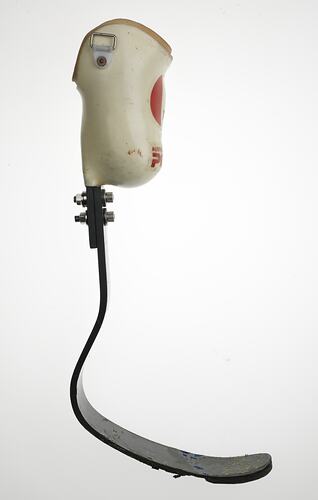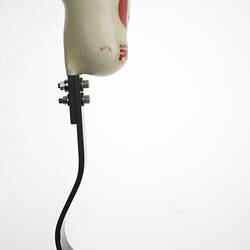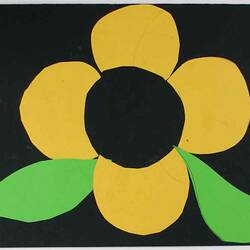Summary
Transtibial prosthesis - socket and component foot. The socket is white and bears the logo of Australia Post, the donor's employer and sponsor. Worn by champion athlete Don Elgin when he won the Bronze medal in the Pentathlon at the 2004 Athens Paralympic Games.
The socket was made for the donor at Advanced Prosthetics Centre, Sydney. The prosthetist was Dr David Howells, the prosthetist to the Australian Paralympic Team. The donor calls Dr Howells 'Professor Leg' because his understanding of prosthetic technology is so sophisticated. The foot component is a 'Cheetah' model made by prosthetics company Össur. It is specifically designed for use in sprinting events.
The day after the donor competed in the Pentathlon Don Elgin broke this foot during training for the 4 x 100 metres relay. He tells the story that he was very glad to have broken the foot - worth $5000 - at the Paralympics, because the Össur representative at the games gave him a new foot on the spot. He says that although the feet are an off-the shelf product, each one does take a bit of time to settle in. It did not seem to have slowed the donor down too much, as he went on to win two more medals, bronze in the men's 4 x 400 metres relay and silver in the men's 4 x 100 metres relay.
Physical Description
Custom made fibreglass transtibial socket with synthetic liner. Ossur 'Cheetah' carbon fibre running leg, cracked.
Significance
Don Elgin is a transtibial amputee. Over the last 12 years he has represented Australia at three Paralympics and three International Paralympic Committee World Championships. In the system used for classifying athletes in disabled sports, Don competes in the T44 Amputee (Single below-knee amputee) class.
Taken as a set, these four prostheses document the significant developments that have occurred in prosthetic technologies over the last three decades, and in the last fifteen years in particular. The medal recognises Don's highest achievement in his chosen discipline, the Pentathlon.
The two older prostheses, made from poplar wood and fibreglass, with rubber SACH (Solid Ankle, Cushion Heel) feet attached by a steel bolt. SACH feet were developed in 1956 and have been one of the more commonly used types of prosthetic feet since then. SACH feet contain a solid keel (central portion of the foot) surrounded by rubber. Most of the foot is a solid rubber, while the heel is a softer rubber compound that compresses to assist with the walking motion.
'Flex-Foot' carbon fibre prostheses represented a paradigm shift in the manufacture of prosthetic feet. According to Dr David Howells, Don's current Prosthetist, and Prosthetist to the Australian Paralympic team, SACH feet are a support, whereas carbon fibre prostheses enable athletes to normalise their movement, creating something close to symmetry between the natural and prosthetic limbs.
The two carbon fibre feet have significant technical differences. The biggest difference is apparent in comparing their shapes. The Modular III foot has a simple curve forward, known as a 'J' curve. While this particular model of the Modular III does not have a heel, one of the set of characteristics of sprinting components, the way that it compresses and returns energy is not ideal for sprinting. It is a very efficient prosthesis, returning 95% of the energy that is directed into it, but it returns it in a 'neutral' manner. In contrast, the 'Cheetah' has a recurved shape, known as a 'C' curve. This shape tends to thrust the foot forward, making it more suitable for the gait of a sprinter propelling themselves forward as quickly as possible.
Don's prostheses also tell his own story. Born with a stump below his left knee, his fingers webbed together and no thumb on his left hand, he was encouraged by his parents to be active and pursue his inclination to sporting excellence. The child's leg is emblematic of the fact that Don was born disabled. The 1993 prosthesis is part of the story of his entry into the world of elite competition, while the legs he wore in Atlanta and Athens mark his struggle to be the best in the world. At Atlanta Don placed fourth and at Athens he won the bronze medal for the second consecutive Paralympics (he also placed third in the Pentathlon at the 2000 Paralympics in Sydney).
Don's story, as told in interviews recorded with him by the Museum, demonstrates his drive to achieve at the highest level, and his refusal to accept that his disability might restrict his ability to do so.
Although the Museum holds a substantial collection of prostheses, it only holds three prosthetic legs/feet, one of which is not registered. While one of the registered limbs has limited provenance, the other was received directly from the manufacturer.
Don won Silver medal for the Pentathlon at the 2002 International Paralympic Committee World Championships, his best individual result in an international competition.
Don has a website with his friend and fellow Paraylmpian, Tim Matthews, www.timanddon.com.au, where they advertise their services as speakers and briefly tell their life stories.
More Information
-
Collecting Areas
-
Acquisition Information
Donation from Don Elgin, 25 Jun 2006
-
Past Owner or User
Don Elgin, Chelsea Heights, Greater Melbourne, Victoria, Australia, 2002
-
Inscriptions
On front: AUSTRALIA / POST / OSSUR / FLEX FOOT Etched on back: 90511
-
Classification
-
Category
-
Discipline
-
Type of item
-
Overall Dimensions
125 mm (Width), 260 mm (Depth), 595 mm (Height)
Height measurement taken with shin section vertical
-
Keywords
Athletics, Disabilities, Disability Technologies, Sport, Legs




